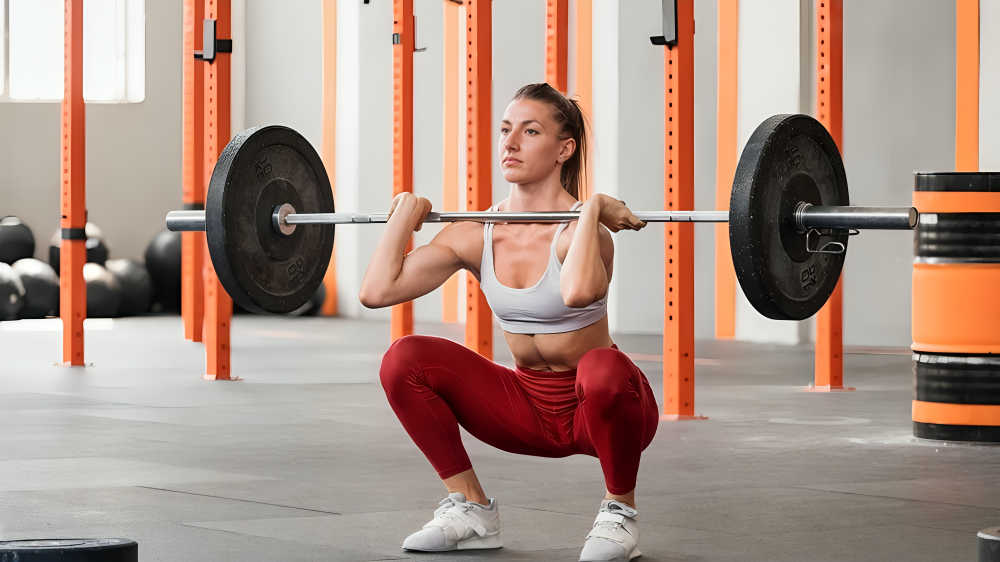
What is a Barbell Squat?
Another compound movement is the barbell squat. It engages several groups and joints in an effort to stimulate the major muscle groups of the body, with a primary emphasis on the quadriceps-the group of muscles in the front of your thighs. The glutes, hamstrings, calves, and core all are also engaged. In fact, for all this, it is incredibly effective in building strength, power, and muscle in the lower body.
How to Do a Barbell Squat
Set Up Your Equipment:
Rack the Barbell: Place the barbell on a squat rack at about shoulder height. Load the desired weight onto the bar and secure it with collars.
Position Your Feet: Stand with your feet shoulder-width apart, toes pointed out slightly. Depending on your comfort and flexibility, your stance might be slightly different.
Position Yourself Under the Bar:
Get Under the Bar: Step under the barbell and position it across your upper back, just beneath the base of your neck. Your hands should be gripping the bar a little wider than shoulder-width apart.
Engage Your Back: Squeeze your shoulder blades together, engage your upper back muscles in such a way that you can create a stable base for the bar.
Lift the Barbell:
Unrack the Bar: Inhale, securing the barbell on your back and engage your core, then stand up to take the bar off the rack. Take one or two steps backward to clear the rack.
Squat Down:
Begin Descent: Accordingly, bend your knees and push your hips back, as if you’re sitting into a chair. Keep the chest upwards and eyes ahead.
Go Deep: Press down until your thighs are at least parallel to the floor or lower, depending on flexibility and comfort. Your knees should track over your toes without caving in.
Stand Back Up:
Drive Through Your Heels: Extend the knee and hip, driving through the heels back into the starting position. Keep core engagement and spine neutrality at all times.
Reset: Take a second to stabilize yourself and ready for the next rep.
The Benefits of Barbell Squats
Builds Lower Body Strength:
The squat is second to none in developing quadriceps, glutes, and hamstring strength, which can be highly useful not only in athletic performance but also in simple physical activities such as stair climbing or lifting.
Squats are a highly effective movement to build lower body mass. Progressive overloading with heavier weights could stimulate the muscle growth and result in a well-toned, muscular appearance.
Improves Functional Fitness:
The squat is one of those natural, functional movements that involve sitting and standing. This improves performance in daily activities and significantly minimizes the possibility of an injury.
Engages Core Stability:
A strong core is the foundation for holding your body straight during the execution of the squat. During the course of performing the movement, a large degree of effort will be applied by your core muscles just to maintain you in balance so that you do not wobble over.
Makes You More Flexible and Mobile:
Squatting regularly can enhance the flexibility of your hips, knees, and ankles; this can be beneficial for other exercises, as well as other activities performed day by day.
Burns Calories and Boosts Metabolism:
A squat uses many muscular groups at once; hence, it is considered one of the most calorie-burning exercises. The gain of muscular mass from squatting, too, can heighten your resting metabolic rate, which contributes to burning more calories even at rest.
How to Get the Most from Your Squats
Dynamic Warm-Up: Do dynamic stretches along with lighter weights for getting your muscles warmed up to lift.
Focus on Form: Quality over quantity, that is better to perform fewer reps instead of doing more reps with poor technique.
Progressive Overload: Increase weight in such a way that there is progressive overload to challenge the muscles further.
Use a Spotter: Particularly with heavy lifting, a spotter will make it safer and also tend to give you more confidence to lift heavier.
Listen to Your Body: Pay attention to how your body feels. If you experience pain (not to be confused with muscle fatigue), stop and reassess your form.
It’s here Exercise for Upper Abs how to do it and what are the Benefits
FAQs
Q: How often should I perform barbell squats?
A: That depends on your goals about fitness and the overall work out schedule. Most people get by just doing squats a couple of times a week, anywhere from 2-3 times. Allow time in between sessions to recover.
Q: Am I allowed to do barbell squats as a beginner?
A: Of course! Beginners should start with lighter weights, or even just the bar, to master form before adding heavier weights. It’s also a good idea to seek guidance from a fitness professional when starting out.
Q: What’s the difference between high-bar and low-bar squats?
A: High-bar squats place the barbell on the upper traps and are more common in Olympic lifting, emphasizing the quadriceps. Low-bar squats position the bar lower on the back, with increased posterior chain muscles recruitment-the glutes and hamstrings-and are a staple in powerlifting.
Q: Should I wear a weightlifting belt while squatting?
A: The weightlifting belt supports the lumbar and core in general, especially when weights become too heavy. However, not everyone needs it. First, work naturally to strengthen the core and then use a belt as needed for support.
Q: How deep should I squat?
A: This should be at least a parallel squat where your thighs are at least parallel to the ground, but know that if one’s flexibility and form allows it, going deeper provides more engagement of the muscles.

